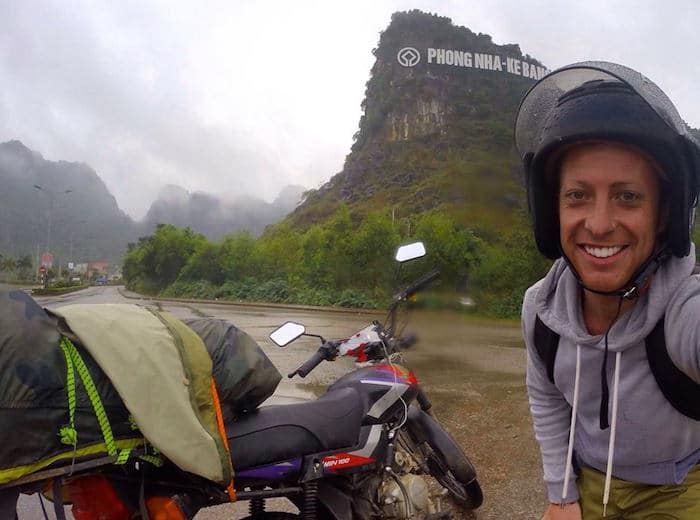Contents
Motorbiking Around Vietnam – A backpackers guide to motorbiking through Vietnam.
“Okay, now turn it on” he said.
I looked at him and blinked. I felt my heart pounding, my face turning as red as the Vietnamese flag. For some reason I knew this moment would come, yet did nothing to prevent the overwhelming embarrassment.
I gripped the handles of the motorbike, attempting to establish my control, my confidence in bikes. You might have heard an intense rev of the engine, had it been on.
“How?” I responded.
I spent the next hour learning the basics of a manual motorbike. I had never driven a motorbike, never driven manual or dealt with a clutch before. And I had certainly never dealt with the crazy undertaking of motorbiking over 2,000 km in a foreign country.
In an effort to save you some of my embarrassment, here is a complete guide to motorbiking Vietnam, everything I wish I knew before blindly embarking on the adventure of a lifetime.
Buying a Motorbike for your trip around Vietnam
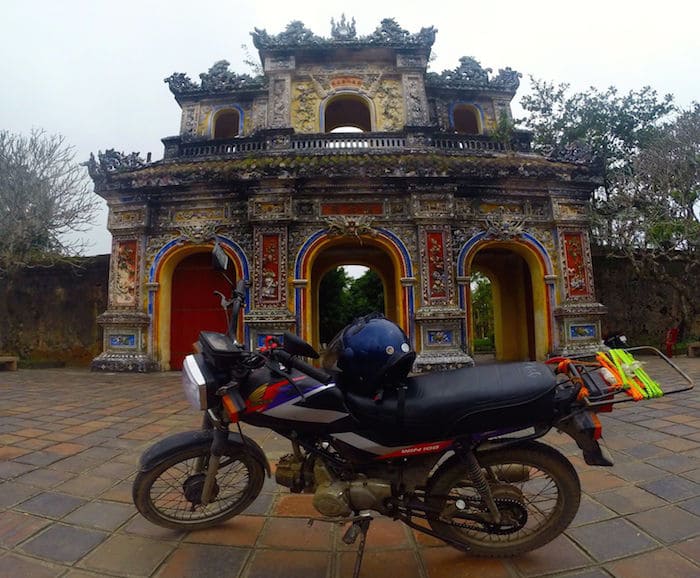
Most people buy Honda Wins, but a semi-automatic or an automatic motorbike will do as well. Keep in mind that they’re mostly Chinese versions of Honda Wins, repaired with Chinese parts, so they are not as reliable and will probably break down.
You have two options for buying your motorbike: a mechanic shop or a fellow backpacker. You can buy from another backpacker for cheap, but be aware that the bike might not have been serviced properly after their long journey.
Since I had no experience with motorbikes, I decided the best option for me would be to buy from a mechanic. I went to Styles Motorbike in Hanoi, recommended by locals and westerners who regularly bring their bikes in for repairs. I tested out a few, and went with a Honda Win 100cc for $290. Styles bike shop taught me how to drive manual (including turning the bike on), promised 24 hour call help (which came in handy when speaking to non-English speaking mechanics), and even 50% buy back in Ho Chi Minh. Sounded good to me.
That being said, assuming it drives and has everything working, don’t spend over $250. Some people may disagree on this, but in my eyes, you can spend a fortune on a terrible bike or you can spend next-to-nothing on a gem. It’s all a crapshoot. The truth of the matter is, you’re going to be repairing the bike along the way no matter how much you buy it for.
Test ride the motorbike. Make certain everything works. Check the lights, signals, horn, mirrors, brakes, kickstart, tires (treads), and gears. Check to see how tight your chain is, as you don’t want it to be too loose. Note that your speedometer will probably not work, and that’s okay because nearly none do.
Essentials for Motorbiking Around Vietnam
Ensure a blue card registration comes with your bike, as you will need it if you get into any trouble with police or want to re-sell it. It does not need to be in your name, you just need to have it.
Invest in a good helmet. You will probably get into some sort of accident on the road. And you’re going to want protection. If you’re looking to save money, this is not the place to cheap out.
Most bikes should come with a luggage rack and bungee cords.
It will probably rain, especially in the north. Be prepared for cold days through the mountains and wear layers, including a poncho and rain pants. Vietnam’s weather can be a bit unpredictable, so be ready for rain around each turn. And don’t be selfish; get a rain cover for your backpack, too.
Before you leave, get a Vietnamese SIM card for emergencies. This way, you can make phone calls in emergencies, Instagram selfies of you and your bike, and check Tinder when you’re bored.
An added bonus my motorbike came with was a phone holder and a USB port attached to the bike’s battery. This way, I could have my GPS in front of me and didn’t have to worry about my phone’s battery dying. I can’t tell you how vital this became as road signs are in Vietnamese and you don’t want to be stranded with a dead phone.
On the Road – Miles per day for your Vietnam Motorbiking Adventure
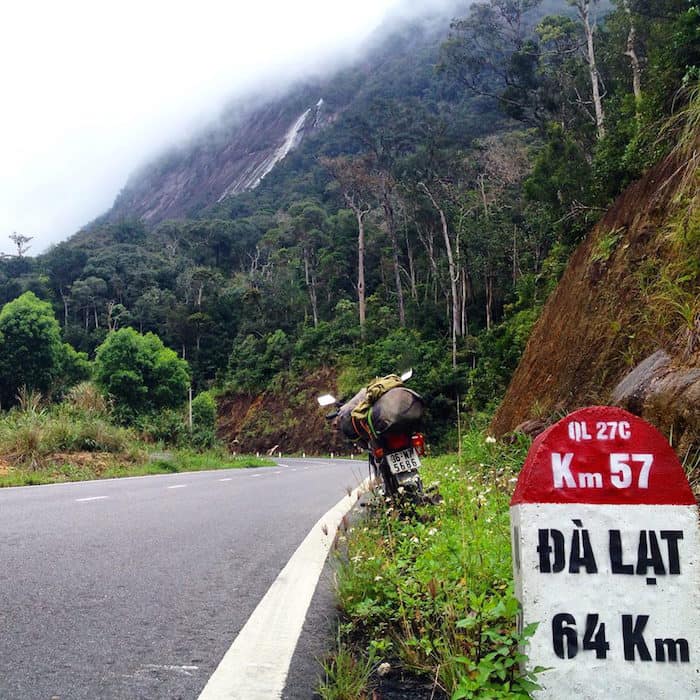
I rode anywhere from 100 km to 280 km per day. It’s best to stick to around 200 km, about 6 hours, for you and your bike. Driving over 6 hours a day is exhausting. On my longer days, I got off the bike with extreme pain in my eye from riding into the sun and focusing so hard. Be sure to take breaks: for water, food, pictures, and your bike. Don’t always race to get there; in this case, the journey is just as amazing as the destination, sometimes better.
Wear long pants and long sleeves. As hot as it might get, covering your skin will protect from sun exposure and can act as padding if you happen to fall off your bike. Direct contact with pavement will not be pretty.
Motorbiking route through Vietnam
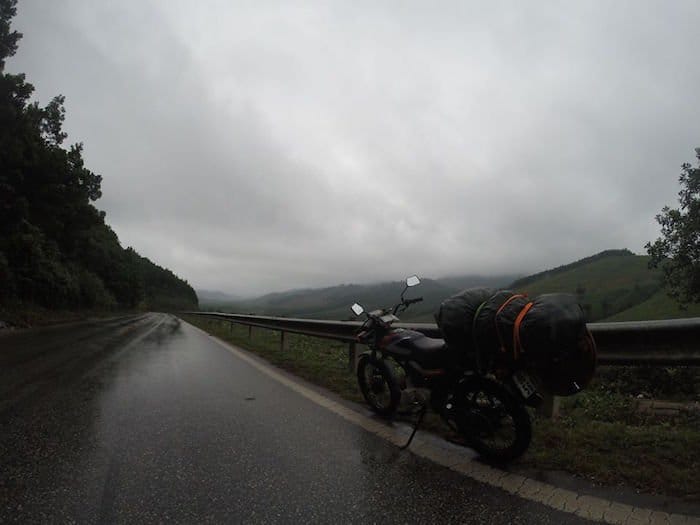
Because Vietnam is a narrowly vertical country, people either travel north to south or vice versa, between Hanoi and Ho Chi Minh. It seemed easier to sell in the north and buy in the south, so it may be best to start in Ho Chi Minh. But this could vary depending on the tide of travelers.
I started in Hanoi, the north. There are a few routes you can take to get from north to south. Your best option is the Ho Chi Minh Trail, an inland route that provides breathtaking scenery of mountains, rivers, and local villages. And you avoid the heavy traffic of trucks and buses on the more direct coastal route, QL1A.
Download Maps.Me. It’s an app that has saved my life. When you have WiFi, download the Vietnam map with GPS. The app allows you to use GPS and your map even when you don’t have WiFi so it’s perfect for driving in a foreign country, with marked gas stations, attractions, and your current location (for when your stumbling home from the bar).
Parking Your Bike
Most hostels offer some sort of secure parking for your motorbike. I never locked mine up, but if you are uncomfortable, you can lock up the front wheel to prevent anyone from wheeling it away. Try to keep it undercover as well, as if it rains, the water can get into your bike and cause problems.
In cities, be careful where you park. There are almost always parking “lots” on sidewalks and streets. But you can’t just park anywhere…
On one occasion, a friend and I parked on a city street only to jump off and take a photograph. On our way back to the bikes, not three minutes later, police were putting them onto a flatbed truck. Our hearts raced as we sprinted to them. The police did not speak any English, so with a bit of charades and the sorriest, most innocent faces we could make, they nicely gave our bikes back. But I don’t know what we would have done if we had been a minute later. Note: Vietnam does in fact have tow trucks.
Police in Vietnam
With that being said, the police shouldn’t bother you on the road. In the event they do, they’re most likely just looking for bribe money. Most times I would just drive right by them, but be smart. If they have their helmets on, they may chase you down.
If you do choose to pull over, turn your bike off and put the keys in your pocket. Do not hand over your passport, visa, or blue card. Once they have it in their hands, they will fine you an absurd amount to get it back or take your bike from you. Be polite and do not anger them. Sometimes pretending not to speak English helps.
It’s smart to keep a fake wallet on you. I’d keep 200,000 VND (~ USD $9) in it. They’ll usually ask for around 500,000 VND, but may settle for less.
And keep in mind that it is illegal for foreigners to drive motorbikes in Vietnam. Police do not care if you have an international driver’s license. Apparently, they require a Vietnamese license, which are not easy to obtain and not worth it unless you will be living in Vietnam long-term. So at the end of the day, you’re taking a risk. But an amazing, life-changing one at that.
Petrol & Oil for your bike
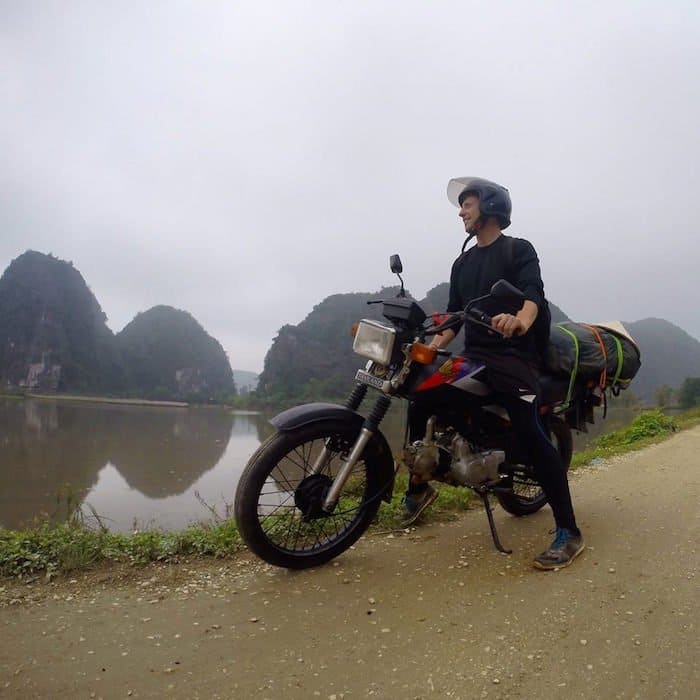
Petrol is super cheap throughout Vietnam. Honda Wins typically have 9 liter petrol tanks, usually lasting 300 km. In riding over 2,000 km, I spent a whopping total of $42.67 USD on petrol.
Change your oil every 500 km. It should cost you 70,000 VND – 90,000 VND. Any more and you are getting ripped off.
Key Words to know in Vietnam
Ngha Nhi = Guesthouse
* There are tons of guesthouses along the way, whichever route you take. You shouldn’t have trouble finding a place to stay, as even locals may offer you a bed in their own home for the night.
Xe May = Motorbike Mechanic
* If and when you have bike issues, there are mechanics nearly everywhere. Just about everyone in Vietnam knows how to fix a bike, so you shouldn’t have a problem finding help. As a non-Vietnamese, mechanics may try to take advantage of you in poor repairs and high prices. But generally, repairs should be minor and not cost too much. Many mechanics do not speak English, so I found it helpful to phone the mechanic from Styles Bike Shop in Hanoi to translate, give input, and negotiate fair prices.
These will be the most common signs you see along your trip. You will dream about these words and wake up repeating them. In some rare cases, they may haunt you forever.
Preparing for breakdowns during your Vietnam trip

One thing I learned was that breakdowns are inevitable. Embrace them, and the cost of them, as part of the adventure. Check your perspective. So what if you’ve fallen off your bike, you’re hand is bleeding, it’s raining, you gears are jammed so you can only climb the mountain in first gear, and you’re alone? You’re motorbiking Vietnam. Life could be worse.
And yes, true story. But the best part? On the other side of the mountain, I had a wonderful family who welcomed me into their home for lunch while a mechanic fixed my bike: a home cooked meal, charades with locals, and homemade rice whiskey. Surely, life could be worse.
Vietnam’s Traffic
Vietnam’s cities are notorious for heavy traffic and congestion. Be vigilant and take your time as you leave and enter cities. Some bike shops may even offer to help drive you out of the city.
On the road, you will encounter cars, trucks, and buses overtaking traffic, whether there is oncoming traffic or not. The general rule is: the bigger vehicle has the right of way. So as a motorbike, close your eyes and hope you don’t get hit get out of the way. I had many times where I had to drive off the road in order to avoid being hit.
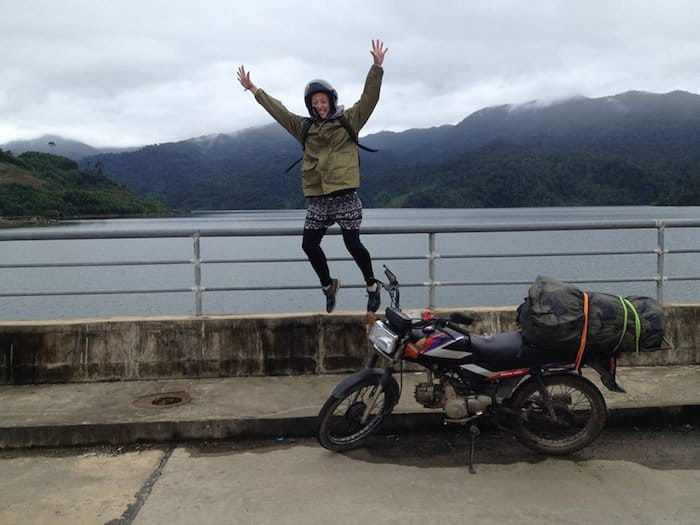
Traffic “Rules”
- Red lights are simply stop signs
- Your horn is your best friend (it’s not an act of aggression)
- Always signal – people will pass you on both sides
- Expect people driving on the wrong side of the road
- Vehicles do not stop for pedestrians
Places of Interest during your Vietnam motorbike trip
Sapa – Mountain town offering treks to nearby villages of ethnic minorities.
Ha Giang/Bac Ha – Scenic mountain road along the Chinese/Vietnamese border.
Halong Bay – Amazing blue waters with giant limestone karst formations towering above the water. Take a junk cruise tour of the majestic UNESCO World Heritage Site.
Hanoi – The capital of Vietnam, known for crazy traffic, ancient pagodas, and the buzzing Old Quarter.
Ninh Binh/Tam Coc – The Halong Bay of land, giant limestone karst overlook beautiful rice paddies.
Phong Nha-Ke Bang National Park – Home to the largest cave in the world, Hong Son Doong, discovered in 2009. Although this cave costs $3000 USD for an expedition inside and is booked until 2017, the national park offers many other impressive caverns. Highlights: Paradise Cave and the Dark Cave.
Hue – An UNESCO world heritage site and home to the Citadel and the Imperial City. Discover old tombs, palaces, and the rich history of Vietnam.
* Be sure to ride the Hai Van Pass, as it is a beautiful coastal mountain pass and a highlight of the ride.
Da Nang – A coastal town on the rise. Be ready for nice beaches but a lot of construction.
Hoi An – A charming town with cobblestone streets, vibrant lanterns, and tailor shops everywhere. Have an affordable, custom suit or dress made in two/three days, and relax on the nearby beaches in between fittings.
Nha Trang – Overrun by Russians, Nha Trang is a resort town and prices are rising above the backpackers wallet. Don’t feel bad for skipping, as it barely feels like Vietnam and more of a vacation town.
Da Lat – A mountain town known for it’s many flower farms and waterfalls. For those seeking adventure, go abseiling down cliffs and waterfalls.
Mui Ne – Another coastal town with little to offer. With strong winds and rubbish everywhere, the beaches are difficult to enjoy. The Fairy Stream and White Sand Dunes are worth a visit though. Beware of police here. On the main strip, maybe 10 km north of town, police have set up a traffic stop from 9am – 5pm every day. And they will charge you absurd fines. Take a longer detour around town or travel early/late in the day.
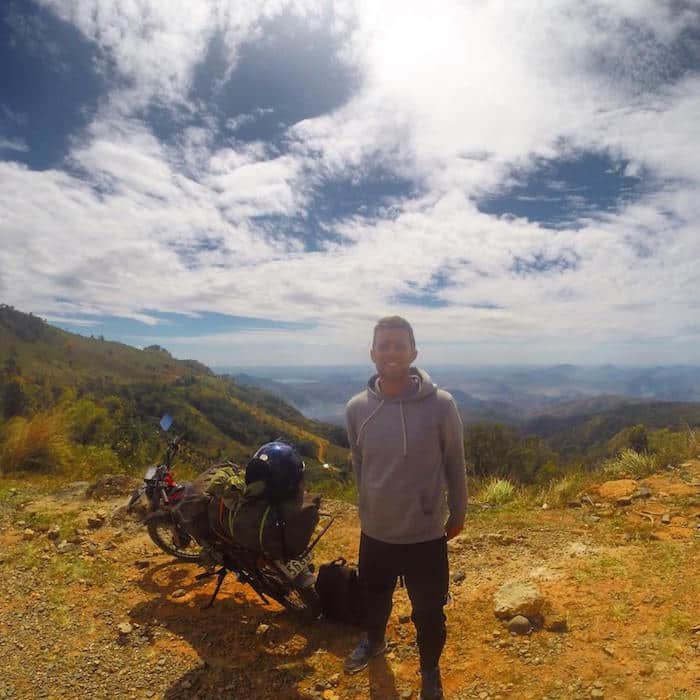
Ho Chi Minh City – Another city known for chaotic traffic, with a lot of American/Vietnam War sites to visit. HCMC serves as a hub for travel north or into Cambodia.
Mekong Delta – Visit the local villages that live on the river, with floating markets and home stay experiences.
Phu Quoc – An island on the southern tip of Vietnam, known for its beaches and scuba diving.
Timeline for a motorbiking through Vietnam
Give yourself enough time to get to your final destination. I met people who sped through the country in 2 1/2 weeks. And It’s possible, but you have virtually no time to enjoy the towns, cities, and sites along the way. I took 4 weeks from north to south, with 13 days of riding, and found it to be the perfect amount of time. On average, I spent about 3 days in each town.
Whatever your timeline, add an extra week to it. You never know what will happen on the road that may hold you back: bike breakdowns, bad weather, or budding romances.
Selling your bike after your trip

Give yourself around a week in your destination city to sell your bike. If you only have a few days, you might have to sell for cheap to sell quickly. Post on craigslist before you arrive to start interest early. And post flyers in all the popular hostels. Maybe give your bike a cleaning or detailing. Other than that, backpackers are looking to buy quickly, so you should be able to sell easily.
Expenses overview – What it costs to Motorbike through Vietnam
The bike was bought for: $290.00
Repairs: $160.14
Gas: $42.67
Sold for: $200
Cost: $292.81
*Most other travelers only lost $50-$100 for their trip. My bike had a little more trouble than most. There’s no way of knowing how good or bad a bike really is until you’re in the middle of your trip. And by that time, there’s nothing you can do but ride on.
I sold mine in two days to Patrick for $200, a low price to sell quickly. We met outside his hostel in Ho Chi Minh, amid a frenzy of backpackers and traffic.
“Do you want to take it for a ride?” I offered.
Patrick looked at me and with red cheeks, laughed.
“I’ve actually never ridden a motorbike. Could you just drive it around and I’ll ride on the back?”
I laughed. Not at him, but at myself. I used to be Patrick, having had zero experience with motorbikes, not even the ability to turn it on. And here I am a month later, with enough knowledge and confidence to pass on to another backpacker. And now to you.
Final thoughts – Why you should motorbike through Vietnam
If none of this information sticks, I at least hope you understand how incredible a trip like this is. I’m a firm believer that the best way to see a foreign country or city is on your own: no tours, no buses, no pre-booked itineraries. You will understand the country from an authentic, unfiltered perspective.
So what are you waiting for? Buy a motorbike, learn how to turn it on, and breakdown. It will be the ride of your life.
Helpful articles and blog posts about motorbiking through Vietnam.
We only recommend writers and blogs that we read regularly and believe will deliver substantial value to our readers. The following is our top picks of articles we think are worth reading for more reviews and information on motorbiking though Vietnam!
- Nomadasaurus – Guide To Buying A Motorbike In Southeast Asia
- Vietnam Coracle – Expenses for motorbiking through Vietnam
- Nomadasaurus -Northern Vietnam Motorcycle Adventure
- OpenWorldMag – 44 days in Vietnam – My Motorcycle ride through the country
- Random Travel Blog – An Idiot’s Guide To Riding Through Vietnam By Motorbike
- Happy Travel – Vietnam On A Motorbike Part 1: Why You Should Go Biking
- Paula Through the Looking Glass -The Complete Guide to Motorbiking the Length of Vietnam
There is also a complete backpackers guide of Vietnam covering the major cities, what to do, what to see and where to stay in our backpackers travel guides to South East Asia.
Do you have an awesome link to a relevant well written article that should be included here? If so, hit us up on Twitter by following and messaging us the link. Looking for the best budget stays in Bangkok?
About the author



